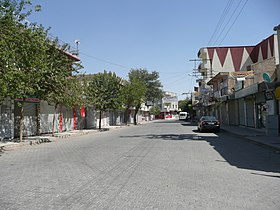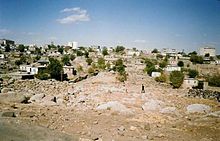İdil
| İdil | ||||
|
||||

|
||||
| Basic data | ||||
|---|---|---|---|---|
| Province (il) : | Şırnak | |||
| Coordinates : | 37 ° 21 ' N , 41 ° 54' E | |||
| Residents : | 28,199 (2018) | |||
| Telephone code : | (+90) 486 | |||
| Postal code : | 73 3xx | |||
| License plate : | 73 | |||
| Structure and administration (as of 2019) | ||||
| Structure : | 5 malls | |||
| Mayor : | Murat Şen ( HDP ) | |||
| Website: | ||||
| İdil County | ||||
| Residents : | 76,523 (2018) | |||
| Surface: | 1,148 km² | |||
| Population density : | 67 inhabitants per km² | |||
| Kaymakam : | Ali Karakaya | |||
| Website (Kaymakam): | ||||
İdil (historically Aramaic ܒܝܬ ܙܒܕܐ Beth Zabday orܐܙܟ Āzaḵ ; Arabic آزخ Azech , Kurdish Hezex ) is a small town and a district in the southeast Anatolian province of Şırnak in Tur Abdin in Turkey .
The İdil district borders the Mardin province to the west . In addition to the district town (almost 37 percent of the district population), it consists of two other municipalities ( Belediye ): Karalar (4,107) and Sırtköy (2,170 inhabitants) and 63 villages ( Köy , mostly Köyler ), of which 13 have more than 1,000 inhabitants . Pinarbaşi (2,864), Oyali (2,309) and Tekeköy (2,144 inhabitants) are the largest. On average, 667 people live in each of the 63 villages.
location
İdil is about 54 km west of the provincial capital Şırnak as the crow flies , other villages in the area are distributed as follows:
|
Dargeçit 53 km |
||
|
Öğündük 17 km |

|
Cizre 28 km |
|
Günyurdu 63 km |
climate
The seasons are very distinctive. Lots of rainfall in spring and autumn; hot and dry summers, cold and heavily snowed winters. The temperature fluctuations range from −10 ° C in winter to +52 ° C in summer.
population
İdil is mostly inhabited by Kurds , besides there are Turks , Arabs and Arameans . According to the population structure, Kurdish and Turkish are spoken predominantly . As a local peculiarity, a dialect of the Aramaic language, the Azcheni, has developed in İdil under Arabic influence . It is one of the turoyo dialects . Speakers of this dialect live almost exclusively outside of İdil today.
Originally, Azech was almost exclusively inhabited by Assyrians . Nowadays the majority of the residents are Muslim . Only a small part of the population belongs to the Syrian Orthodox Church and thus only reflects a small part of the former population structure.
history
The place to ancient times
Beth Zabday is a historic Mesopotamian settlement. It is not known exactly when the city was founded.
Beth Zabday was Christianized early, according to legend by Mor Agai, the first bishop of Urhoy , and Mor Aho, also from Urhoy. A bishop of Beth Zabday is known as early as 120; the city was one of 17 bishoprics in the east in the 3rd century.
Persian Wars
On April 28, 226 the Persians conquered the city under Ardaschir I. Ben Babek , the founder of the Sasanian Empire . The Persian King Shapur II (310–379) suppressed the inhabitants of the area in the years 337–339, allegedly 120,000 people fell victim to his regime in a single day, 9,000 of them in Beth Zabday. Various sources report on the various places of exile of the inhabitants who were not killed.
After the Syrian officer Felib became Roman emperor as Philip Arabs in 244 , he concluded a peace agreement with the Persians that secured peace in the border areas for a few years.
In 360 Bushabur conquered Beth Zabday for the Persians and appointed his brother Zert as regent of the city. In 362 he moved part of the population to the east of the Persian Empire. For a long time the city belonged to Persia and the Persian Church ( Old Apostolic Church of the East ).
19th century
At the beginning of the 19th century, Schammas Stayfo directed the fortunes of Beth Zabday. He was succeeded by his nephew Shaq Bazo . This refused the usual tribute to Mire Botan , the Kurdish Emir of Botan, who had his seat in what is now the city of Cizre . Then Beth Zabday attacked the city together with Mire Kora , the “one-eyed emir” of Rewanduz . This ushered in the first major escape movement in the history of Beth Zabday. Numerous girls and women were abducted to Iraq .
20th century
During the First World War, the Turkish army - supported by the German army and Kurdish warlords - besieged the city from the beginning of August 1915. In the winter of 1916/1917, after the destruction of the fields, there was famine and disease. Many families emigrated, especially to nearby Qamishli in what is now Syria and to Lebanon .
With the Sykes-Picot Agreement (1916), today's national territories were assigned to the then mandate powers France and Great Britain, and Turkey was not yet a fixed border. In 1923, at the Lausanne Peace Conference , it was decided to assign what is now the territory of Beth Zabday to the newly founded Turkish Republic.
After the First World War , the new secular Turkish Republic under Kemal Ataturk granted Christians and Muslims the same rights as citizens and gave Turkish surnames to the Syrian Christians who were not of Turkish origin. The general living conditions of Christians improved and the relationship between Christians and Muslims relaxed somewhat as a result. The city received the Turkish name İdil.
With the outbreak of World War II , many men were drafted and there was a great famine in the Tur Abdin . In addition, there were always clashes with Kurdish Muslims. Hundreds of families emigrated to Derik (Malikiye) in present-day Syria, just 20 kilometers south-east .
Against the background of the Greek-Turkish disputes and the Cyprus crisis in 1964, the Kurds once again exerted increased pressure on the Arameans of Tur Abdin. Again many Aramaeans left Beth Zabday. Most of them follow relatives who have already emigrated to the Syrian city of Derik, while a minority went to Qamishli, Iraq and Lebanon .
When the Syrian Orthodox mayor and some influential men were assassinated in the run-up to the mayoral elections in 1974, and a Muslim ran for the position of the traditionally Christian mayor, this triggered the largest wave of emigration to date, this time to Europe. It peaked in 1978 when a Muslim assumed the office of mayor. Larger communities of emigrants have formed in some places and areas in Sweden and Germany. Individual families settled in numerous other countries.
Economy and Supply
In addition to handicrafts, the residents of this city mainly practice agriculture. They live from growing grain , wine , fruit and vegetables as well as from livestock and beekeeping.
When a recruiting office in Diyarbakır recruited foreign workers for Germany in the early 1960s , many families sent their grown sons to work in Germany so that they could contribute to the livelihood of the families in İdil.
People born in İdil
- Jacques Behnan Hindo (* 1941), Syrian Catholic Archbishop of Hassaké-Nisibi
- Leyla Bilge (* 1981), German, Kurdish women's rights activist and AfD politician
literature
- Sebastien De Courtois: The Forgotten Genocide: Eastern Christians, The Last Arameans . In: Tur Abdin suffers two waves of attacks, The villages of the resistance . 2004, ISBN 1-59333-077-4 , p. 34.
Web links
swell
- Article by Raif Toma "Azekh City of the Brave"
Individual evidence
- ↑ a b Türkiye Nüfusu İl ve İlçelere Göre Nüfus Bilgileri (Nufusune.com) , accessed on April 23, 2019
- ↑ Ṯaʿālebī, Ḡorar, p. 530; Acta Martyrum, II, p. 154.



